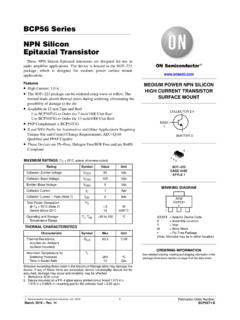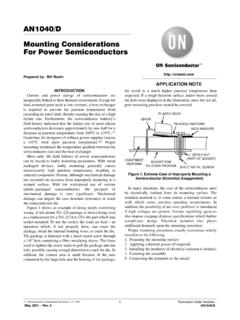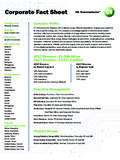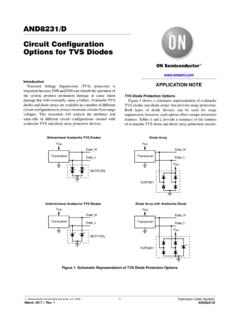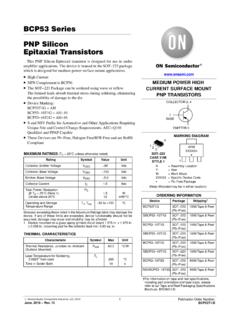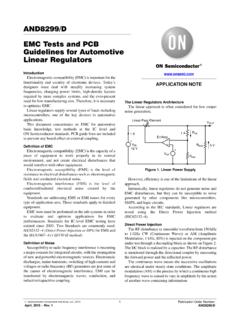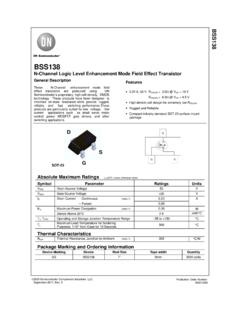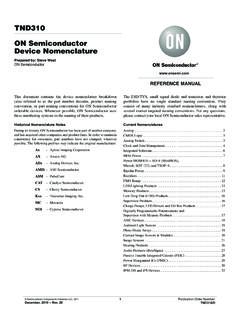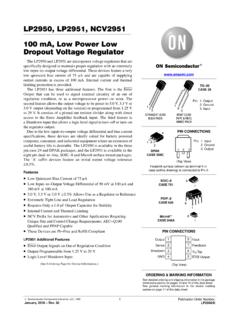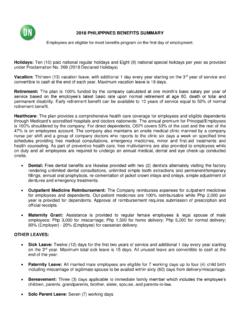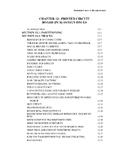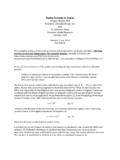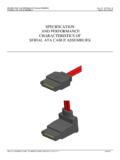Transcription of NCP1288 - Current Mode Controller for Flyback …
1 Semiconductor Components Industries, LLC, 2011 July, 2011 Rev. 31 Publication Order Number: NCP1288 /DNCP1288 Controller , Fixed Frequency, Current Mode, for Flyback ConvertersThe NCP1288 is a new generation of the NCP12xx fixed frequency Current mode controllers featuring a high voltage startup Current , pin to pin compatible with the previous to its proprietary Soft Skip mode combined with frequency foldback, the Controller exhibits excellent efficiency in light load condition while still achieving very low standby power consumption. This Soft Skip feature also dramatically reduces the risk of acoustic noise, which enables the use of inexpensive transformers and capacitors in the clamping frequency jittering, ramp compensation, and a versatile latch input make this Controller an excellent candidate for converters where ruggedness and components cost are the key addition, the Controller includes a new high voltage circuitry that combines a startup Current source and a brown out / line OVP detector able to sense the input voltage either from the rectified ac line or the dc filtered bulk , due to a careful design, the precision of critical parameters is well controlled over the entire temperature range ( 40 C to+125 C)
2 , enabling easier design and increased safety ( $5% forthe peak Current limit, $7% for the oscillator).Features Timer Based Overload Protections with Auto Recovery (Option B) or Latched (Option A) Operation High Voltage Current Source with Built in Brown outand Line Overvoltage Protections Fixed Frequency Current Mode Operation withBuilt in Ramp Compensation Frequency Jittering for a Reduced EMI Signature Adjustable Overpower Compensation Latch off Input for Severe Fault Conditions, withDirect Connection of an NTC for OvertemperatureProtection (OTP) Protection Against Winding Short Circuit Frequency Foldback transitioning into Soft Skip forImproved Performance in Standby 65 kHz Oscillator (100 kHz and 133 kHz VersionsAvailable Upon Request) VCC Operation up to 28 V Increased Precision on Critical Parameters A Peak Drive Capability ms Soft Start Internal Thermal Shutdown with Hysteresis These Devices are Pb Free, Halogen Free/BFR Freeand are RoHS Compliant*Typical Applications ac dc Adapters for Notebooks, LCD, and Printers Offline Battery Chargers Consumer Electronic Power Supplies Auxiliary/Housekeeping Power Supplies*For additional information on our Pb Free strategy and soldering details, pleasedownload the ON Semiconductor Soldering and Mounting TechniquesReference Manual, 7 CASE 751 = Specific Device CodeX = A or Bff = 65, 00, or 33A= Assembly LocationL= Wafer LotY= YearW= Work WeekG= Pb Free PackageSee detailed ordering and shipping information in the packagedimensions section on page 38 of this data INFORMATIONNCP1288 1.
3 PinoutTYPICAL APPLICATION EXAMPLEVOUTVIN(dc) NCP1288 LATCHFBCSGNDHVVCCDRVF igure 2. Typical ApplicationPIN FUNCTION DESCRIPTIONPin N5 Pin NameFunctionPin Description1 LATCHL atch off InputPull the pin up or down to latch off the Controller . An internal Current source allowsthe direct connection of an NTC for over temperature detection2 FBFeedbackA pull down optocoupler controls the output SenseSenses the primary Current for Current mode operation, and provides a mean foroverpower compensation IC ground5 DRVD rive OutputDrives an external MOSFET6 VCCVCC InputThis supply pin accepts up to 28 Vdc8 HVHigh Voltage PinConnects to the bulk capacitor or the rectified AC line to perform the functions ofstart up Current source and brown out / line overvoltage detectionsNCP1288 INTERNAL BLOCK SCHEMATICF igure 3. Simplified Internal Block SchematicResetBrown outCSFB +blankingtimerVDD + ++ ++SRQSoft startStartResetIC StartIC StopOscillatorHVVCCL atch ++V skipProtectionModereleasetimerAutorecove ryprotectionmode onlyDRVHV sampleOVMBOC lampUVLOF aultResetSawtoothJitterHV stopBrown outHV stop +V to IHV sample ++LatchDual HVstart upcurrent sourceVCCmanagementHV currentTSDVDDUVLOR esetTSDS tartIC StartSkipPWMSoft startResetVDDUVLOSoft skip rampIC stopTSDTSDHV dcPWMF ault FlagFoldbackFBGNDFBStopSkipSRQblanking +SRQ +blankingBrown outResetLatchVclampblanking1 kW++Soft startendSoft start = x(VHV 125)VDDINTCINTCVOVPVOTPtLatch(OVP)tLatch (OTP)tSSKIPRFB(up)KFBILIMITDMAXtSSTARTVF B(OPC)tLEBtBCSVILIMILIMITVCS(stop)DCMAXD MAX tfaulttautorecNCP1288 RATINGSR atingSymbolValueUnitSupply Pin (pin 6) (Note 1)
4 Voltage rangeCurrent rangeVCCMAXICCMAX to 28$30 VmAHigh Voltage Pin (pin 8) (Note 1)Voltage rangeCurrent rangeVHVMAXIHVMAX to 500$20 VmADriver Pin (pin 5) (Note 1)Voltage rangeCurrent rangeVDRVMAXIDRVMAX to 20$1500 VmAAll other pins (Note 1)Voltage rangeCurrent rangeVMAXIMAX to 10$10 VmAThermal ResistanceJunction to Air, low conductivity PCB (Note 2)Junction to Air, medium conductivity PCB (Note 3)Junction to Air, high conductivity PCB (Note 4)RqJA162147125 C/WTemperature RangeOperating Junction TemperatureStorage Temperature RangeTJMAXTSTRGMAX 40 to +150 60 to +150 CESD CapabilityHuman Body Model (HBM) per JEDEC standard JESD22, Method A114E (All pins except HV)Machine Model (MM) per JEDEC standard JESD22, Method A115A2000200 VStresses exceeding Maximum Ratings may damage the device. Maximum Ratings are stress ratings only.
5 Functional operation above theRecommended Operating Conditions is not implied. Extended exposure to stresses above the Recommended Operating Conditions may affectdevice This device contains latch up protection and exceeds 100 mA per JEDEC Standard JESD782. As mounted on a 80 x 100 x mm FR4 substrate with a single layer of 100 mm2 of 1 oz copper traces and heat spreading area. As specifiedfor a JEDEC 51 1 conductivity test PCB. Test conditions were under natural convection or zero air As mounted on a 80 x 100 x mm FR4 substrate with a single layer of 100 mm2 of 2 oz copper traces and heat spreading area. As specifiedfor a JEDEC 51 2 conductivity test PCB. Test conditions were under natural convection or zero air As mounted on a 80 x 100 x mm FR4 substrate with a single layer of 650 mm2 of 1 oz copper traces and heat spreading area.
6 As specifiedfor a JEDEC 51 3 conductivity test PCB. Test conditions were under natural convection or zero air CHARACTERISTICS (For typical values TJ = 25 C, for min/max values TJ = 40 C to +125 C, VHV = 120 V, VCC = 11 V unless otherwise noted)CharacteristicsTest ConditionSymbolMinTypMaxUnitHIGH VOLTAGE Current SOURCEM inimum voltage for Current source operationVHV(min) 60 VCurrent flowing out of VCC pin @ VHV = 60 VVCC = 0 VVCC = VCC(on) state leakage currentVHV = 500 VIstart(off) 2550mASUPPLYTurn on threshold level, VCC going upHV Current source stop thresholdVCC(on) and HV Current source restart thresholdVCC(min) between VCC(on) and VCC(min)VCC(HYS) VBlanking duration on VCC(min) and VCC(off) detectionGuaranteed by designtUVLO(blank)71013msVCC decreasing level at which the internal logic resetsVCC(reset) level for ISTART1 to ISTART2 transitionVCC(inhibit) Current consumption (Note 5)DRV open, VFB = 3 VCdrv = 1 nF, VFB = 3 VOff mode (skip or beforestartup)Fault mode (fault or latch) OUT AND LINE OVERVOLTAGEB rown out threshold voltageVHV going upVHV going downVHV(start)VHV(stop)10497112105120113 VTimer duration for line cycle drop outtHV436179msOvervoltage thresholdVHV going upVHV going downVHV(OV1)VHV(OV2)400395430425460455 VBlanking duration on line overvoltage detectiontOV(blank) 250 msOSCILLATORO scillator frequencyfOSC606570kHzMaximum duty ratioDMAX758085%Frequency jittering amplitude, in percentage of FOSCG uaranteed by designAjitter$4$6$8%Frequency jittering modulation frequencyGuaranteed by designFjitter85125165 HzOUTPUT DRIVERRise time, 10% to 90% of VCCVCC = VCC(min)
7 + V,CDRV = 1 nFtrise 2234nsFall time, 90% to 10% of VCCVCC = VCC(min) + V,CDRV = 1 nFtfall 2234nsCurrent CapabilityVCC = VCC(min) + V,CDRV = 1 nFDRV high, VDRV = 0 VDRV low, VDRV = VCCIDRV(source)IDRV(sink) 10001000 mAClamping Voltage (Maximum Gate Voltage)VCC = VCCmax V, DRVhighVDRV(clamp) State Voltage DropVCC = VCC(min) + V,RDRV = 33 kW, DRV highVDRV(drop) 1V5. Internal supply Current only, Current in FB pin not included ( Current flowing through GND pin only). NCP1288 CHARACTERISTICS (For typical values TJ = 25 C, for min/max values TJ = 40 C to +125 C, VHV = 120 V, VCC = 11 V unless otherwise noted)CharacteristicsUnitMaxTypMinSymbol Test ConditionCURRENT SENSEI nput Bias CurrentVCS = VIbias mAMaximum Internal Current SetpointVFB > for Immediate Fault Protection ActivationVCS(stop) Delay from VILIM detection to DRV offVCS = VILIM tdelay 80110nsLeading Edge Blanking Duration for VILIMtLEB190250310nsLeading Edge Blanking Duration for VCS(stop)tBCS90120150nsSlope of the Compensation RampScomp(65kHz) mV / msSoft Start DurationFrom 1st pulse to VCS = COMPENSATIONVHV to IOPC Conversion RatioKOPC mA / VCurrent flowing out of CS pinVHV = 125 VVHV = 162 VVHV = 325 VVHV = VHV(OV2) 5 VIOPC(125)IOPC(162)IOPC(325)IOPC(max)
8 102052104120 138mAFB voltage above which IOPC is appliedVFB(OPC) voltage below which IOPC = 0 VFB(OPCE) VRefresh period for dc operationtWD253545msFEEDBACKI nternal Pull up ResistorTJ = 25 CRFB(up)152025kWVFB to Internal Current Setpoint Division Internal Pull up Voltage on the FB pinVFB(ref) PROTECTIONF ault Timer DurationFrom CS reaching VILIMIT toDRV stoptfault647898msAutorecovery Mode Latch off Time Internal supply Current only, Current in FB pin not included ( Current flowing through GND pin only). NCP1288 CHARACTERISTICS (For typical values TJ = 25 C, for min/max values TJ = 40 C to +125 C, VHV = 120 V, VCC = 11 V unless otherwise noted)CharacteristicsUnitMaxTypMinSymbol Test ConditionFREQUENCY FOLDBACKF eedback Voltage Threshold below which frequencyfoldback startsVFB(fold) Switching FrequencyVFB = Vskip(in) + VfOSC(min)212731kHzThreshold below which the frequency foldback isfinished and the Controller switches at fOSC(min)VFB(endfold) VSKIP CYCLE MODEF eedback Voltage Thresholds for Skip ModeVFB going downVFB going upVskip(in)Vskip(out) Skip DurationFrom 1st pulse to VCS =VFB(fold) / KFBtSSKIP 100 msLATCH OFF INPUTHigh ThresholdVLatch going ThresholdVLatch going Source for Direct NTC ConnectionDuring normal operationDuring soft startVLatch = 0 VINTCINTC(SSTART)
9 7815691182104208mABlanking Duration on High Latch DetectiontLatch(OVP)405570msBlanking Duration on Low Latch DetectiontLatch(OTP) 400 msClamping VoltageILatch = 0 mAILatch = 1 mAVclamp0(Latch)Vclamp1(Latch) SHUTDOWNT emperature ShutdownTJ going upTTSD135150165 CTemperature Shutdown HysteresisTJ going downTTSD(HYS)203040 C5. Internal supply Current only, Current in FB pin not included ( Current flowing through GND pin only). NCP1288 PERFORMANCE CHARACTERISTICSTJ, JUNCTION TEMPERATURE ( C)150125100250 50357911 VCC, SUPPLY VOLTAGE THRESHOLDS(V)Figure 4. Supply Voltage Thresholds TemperatureFigure 5. Inhibit Threshold Voltage TemperatureFigure 6. Inhibit Current vs. JunctionTemperatureFigure 7. Startup Current vs. JunctionTemperatureFigure 8. Minimum Startup Voltage Temperature7550 25TJ, JUNCTION TEMPERATURE ( C)150125100250 , INHIBIT THRESHOLD VOLTAGE(V)7550 25468101213TJ, JUNCTION TEMPERATURE ( C)150125100250 50360400440480520 Istart1, INHIBIT Current (mA)7550 , JUNCTION TEMPERATURE ( C)150125100250 , STARTUP Current (mA)7550 , JUNCTION TEMPERATURE ( C)150125100250 5005101530 VHV(min), MINIMUM STARTUPVOLTAGE (V)7550 252025TJ, JUNCTION TEMPERATURE ( C)150125100250 50010203040I(start(off), STARTUP CIRCUIT LEAK-AGE Current (A)7550 2551525354550 VCC(reset)VCC(min)VCC(on) = 0 VVCC = VCC(on) = VIHV = X Istart2 VHV = 500 VFigure 9.)
10 Startup Circuit Leakage Current Temperature1416151718 NCP1288 PERFORMANCE CHARACTERISTICSTJ, JUNCTION TEMPERATURE ( C)150125100250 508090100110120 VHV, BROWN OUT CIRCUITTHRESHOLDS (V)Figure 10. Brown Out Circuit Thresholds TemperatureFigure 11. Line Overvoltage Circuit Thresholdsvs. Junction TemperatureFigure 12. ICC Supply Currents vs. JunctionTemperatureFigure 13. Oscillator Frequency vs. JunctionTemperatureFigure 14. Maximum Duty Ratio vs. JunctionTemperature7550 25TJ, JUNCTION TEMPERATURE ( C)150125100250 50410415420425435 VHV, LINE OVERVOLTAGE CIRCUITTHRESHOLDS (V)7550 258595105115125130TJ, JUNCTION TEMPERATURE ( C)150125100250 , OPERATING SUPPLY Current (mA)7550 , JUNCTION TEMPERATURE ( C)150125100250 5045556575fOSC, OSCILLATOR FREQU
